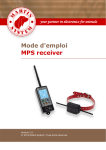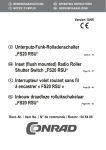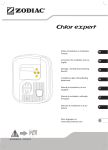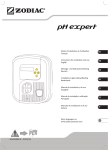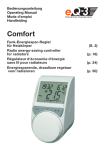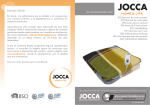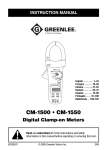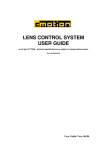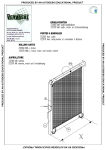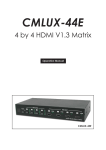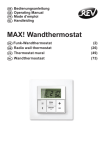Download Notice
Transcript
1 NL 25 EN 45 3000 Beagle Master 4by4 FR Pro Trainer 3000 & Beagle Master 4by4 - User’s guide FR PRO TRAINER 3000 et BEAGLE MASTER 4 BY 4 La technologie et le savoir-faire au service de la performance. Martin System est le pionnier mondial des technologies électroniques au service de l’animal. DECLARATION « CE » DE CONFORMITE Directive R&TTE 1999/5/CE MARTIN SYSTEM déclare que le collier d’éducation PRO TRAINER 3000 BEAGLE MASTER 4 x 4 satisfait à toutes les dispositions de la Directive n° 1999/5/CE du 07/04/99 du Conseil Européen et est conforme aux normes suivantes : SAFETY (art 3.1.a) : EN 60950 (not applicable because no powered and no connection with power network, powered by battery. EMC (art 3.1.b) : EN 300.489-3 V1.4.1 SPECTRUM (art 3.2) : EN 300.220-3 V1.1.1 Lieu et date de ce document : Lantin, 1er novembre 2008 MARTIN SYSTEM Rue Joseph Martin, 35 4450 LANTIN - BELGIUM Signé par ou pour le fabricant : Nom : Charles Martin Titre : Administrateur FR Madame, Monsieur, Félicitations, vous venez d’acquérir un matériel de grande qualité, à la pointe des technologies mondiales. Quelques conseils d’utilisation pour profiter au maximum de votre achat sont indispensables. Il est fortement conseillé de lire attentivement les paragraphes relatifs aux techniques de l’éducation canine (ci-dessous) avant d’utiliser le matériel que vous venez de choisir. De la bonne compréhension de ces quelques conseils dépendra la satisfaction que vous récolterez de votre investissement. 3 TABLE DES MATIERES Techniques de l’Education Canine 1. Quelles sont les motivations qui conduisent un chien à accepter une éducation?.............................................................................................6 2. Philosophie de l’éducation canine 2.1 Enseigner...................................................................................................6 2.2Supprimer les mauvaises habitudes..........................................................6 3. L’entraînement du chien 3.1 Humain.......................................................................................................7 3.2 Pro Animal..................................................................................................7 3.3 Efficace......................................................................................................7 4. Différentes techniques d’utilisation du collier 4.1 4.2 4.3 4.4 4.5 Stimulation de correction..........................................................................8 Entraînement «aversif».............................................................................8 Dressage d’extinction ...............................................................................8 Méthode de contact...................................................................................8 Pour éduquer un chien sourd.....................................................................9 Mode d’emploi 1. Présentation............................................................................................... 10 1.1 1.2 1.3 1.4 1.5 Programmation de la télécommande Pro Trainer..................................... 11 Mise en route et arrêt du collier............................................................... 12 Connexion du collier récepteur................................................................ 12 Choix du niveau de stimulation................................................................ 13 Choix du mode de fonctionnement........................................................... 13 FR 2. Remplacement des piles 2.1 Emetteur = télécommande...................................................................... 15 2.2 Collier récepteur ..................................................................................... 15 3. VÉRIFICATION DU FONCTIONNEMENT........................................................... 16 4. PLACEMENT DU COLLIER SUR LE CHIEN......................................................... 16 5. AMELIORATION DES PERFORMANCES............................................................ 16 6. PRÉCAUTIONS D’USAGE.................................................................................. 17 7. ENTRETIEN..................................................................................................... 17 8. CARACTÉRISTIQUES TECHNIQUES................................................................. 17 9. SPECIFICITE DU RECEPTEUR S.S.C. : STIMULATION A SENSATION CONSTANTE (BREVETE)..................................................................................................... 20 10. GARANTIE...................................................................................................... 21 11. CONFORMITÉ................................................................................................. 22 12. RECYCLAGE.................................................................................................... 22 Techniques de l’Education Canine 1. Quelles sont les motivations qui conduisent un chien à accepter une éducation? Les raisons qui peuvent pousser un chien à obéir sont: ● l’apport de sensations agréables ● la suppression de sensations désagréables (apprentissage) ● l’esquive de sensations désagréables = entraînement de verrouillage ou entraînement «aversif» (de aversion = répulsion, dégoût…) 2. Philosophie de l’éducation canine. Doit-on enseigner quelque chose au chien ou faut-il lui ôter de mauvaises habitudes? 2.1 Enseigner Les comportementalistes envisagent deux récompenses : ● la récompense positive = apporter de l’agréable ● la récompense négative = supprimer du désagréable Les deux permettent de convaincre l’animal à reproduire un comportement donné. Dans le système d’apprentissage par la récompense positive, 4000 à 6000 exercices sont nécessaires pour obtenir une obéissance relative. C’est la raison pour laquelle la plupart des gens échouent dans leur entreprise. (Pas assez de répétitions). Grâce aux techniques d’éducation utilisant les récompenses négatives, seulement 400 à 600 cycles d’apprentissage sont nécessaires. (10 x plus rapide). De plus, en cas de désobéissance intempestive, l’animal comprendra beaucoup mieux la correction électronique. 2.2 Supprimer les mauvaises habitudes Pour vraiment éliminer un comportement non désiré, il faut coupler celui-ci à une stimulation désagréable suffisante (aversive). L’animal va réagir à la stimulation désagréable par un réflexe de survie. (Au même titre que tout individu normal retire immédiatement sa main d’un jet d’eau trop chaude…). On peut considérer que 90% des propriétaires de chiens n’ont pas consciemment 6 FR éduqué leur chien mais qu’au contraire, c’est le chien qui a éduqué le «maître» à réagir à certains comportements (s’il aboie, on lui ouvre la porte, s’il secoue sa gamelle, on lui donne à boire ou à manger…). Le chien a adapté son comportement à son environnement. Ainsi, beaucoup de comportements indésirables sont venus polluer l’environnement du maître. Le collier électronique d’éducation canine constitue la meilleure solution pour résoudre les problèmes de comportements non désirés. Ceci explique le succès qu’il rencontre. Il répond parfaitement aux aspirations des propriétaires de chiens et constitue un formidable catalyseur d’harmonie entre le maître et l’animal. 3. L’entraînement du chien 3.1 Humain Les chiens ne sont pas des êtres humains. Ils vivent en meute. Dans une démocratie, le chien devient très vite un dictateur. Vous devez êtes le chef de meute, le dominant, votre chien doit vous obéir ! 3.2 Pro Animal Il est interdit dans la plupart des pays européens «de faire souffrir un animal et/ou de lui faire mal». Ces textes de lois sont interprétés différemment dans chaque pays. L’organisation ECMA est un lobby des fabricants de colliers électroniques qui œuvre au plus haut niveau politique pour faire accepter les produits qui répondent aux normes strictes tant du point de vue technologique, que du respect de l’animal et que du respect de la loi. 3.3 Efficace Les colliers électroniques sont d’une grande efficacité. Ils apportent rapidement une solution durable à des problèmes qui auraient demandé une thérapie longue et coûteuse et parfois inefficace (cf. II, point a). Grâce aux colliers d’éducation, les maîtres peuvent gérer la liberté de leurs chiens et assurer leur sécurité. Dans beaucoup de cas, ces outils aident les propriétaires de chiens à préserver l’environnement et la quiétude de leurs voisins. 7 4. Différentes techniques d’utilisation du collier 4.1 Stimulation de correction (stimulation) Si le chien, suite à une forte distraction, ignore un commandement connu, une stimulation suffisante doit le rappeler à l’ordre. Une correction doit toujours être infligée immédiatement, ou, au plus tard, dans les 2 secondes qui suivent la désobéissance. Il est conseillé, au début, d’utiliser parallèlement le collier et une longe (la longe oblige le chien à obéir pour supprimer la stimulation). Arrivé à un certain degré d’éducation, le collier électronique devient une longe invisible. 4.2 Entraînement «aversif» (supprimer les mauvaises habitudes) Marier une stimulation «aversive» suffisante à un comportement non désiré. Attention, ne pas accompagner la stimulation de paroles ou de gestes. L’animal doit croire que son comportement seul détermine la stimulation. 4.3 Dressage d’extinction (apprentissage) Coupler longe et collier électronique dans l’apprentissage (basse stimulation continue). Le relâchement de la tension de la longe et l’arrêt de la stimulation constituent la récompense immédiate. Si après apprentissage le chien refuse d’obtempérer à un ordre connu, alors on peut le punir en utilisant une stimulation corrective (1 à 2 secondes après la faute, en pondérant intelligemment son intensité). 4.4 Méthode de contact (apprentissage) Utiliser une stimulation basse et courte (1/4 de seconde) pour renforcer ou accompagner un commandement déjà connu. L’idée est que le chien accepte cette stimulation accompagnant le commandement pour, plus tard, accepter la stimulation de correction en cas de non-obéissance. De plus, en accompagnant l’ordre d’une stimulation basse, courte (1/4 de seconde), il est possible d’accélérer l’exécution de l’ordre. Cette stimulation d’accompagnement maintient l’attention du chien en éveil. 8 FR 4.5 Pour éduquer un chien sourd La stimulation électronique est un commandement. Par exemple: ● «Viens ici» = une stimulation basse de deux secondes, sans accompagnement verbal. ● «Assis!» = ¼ de seconde de stimulation basse sans accompagnement verbal. A la fin de chaque technique d’éducation envisagée ci-dessus, excepté pour le point 5, le collier électronique est une assurance sur le dressage acquis. Il n’est là qu’en cas «d’accident». ATTENTION ● N’employer le collier qu’avec un chien en bonne santé. ● Si le chien est agressif, consulter un spécialiste. ● En «lisant» votre chien, se rendre compte si la stimulation arrive ou non. ● La stimulation électronique doit être adaptée à la situation. ● Avant toute utilisation, bien lire le manuel et maîtriser la manipulation de l’appareil. 9 MODE D’EMPLOI Les colliers d’éducation Pro Trainer et Beagle Master de Martin System sont des appareils conçus pour l’éducation des chiens. Le collier placé au cou de l’animal génère, via la télécommande, des stimulations qui permettent de maintenir l’attention du chien en éveil, facilitant ainsi son éducation. L’intensité des impulsions, réglable depuis la télécommande, permet de s’adapter à tout type de chien, dans n’importe quelle situation. Un signal sonore (bip) émis (pendant ou indépendamment de la stimulation) engendrera par répétition un réflexe conditionné (réflexe acquis avec l’apprentissage selon la théorie de PAVLOV). Le collier d’éducation de Martin System a été conçu dans le respect du bien-être de l’animal. Il est conforme aux prescriptions techniques ECMA, ainsi qu’aux normes européennes en vigueur. • Le Pro-Trainer 3000 permet de contrôler un ou deux chiens. • Le Pro-Trainer Beagle Master 4 by 4 contrôle de un à quatre chiens. 1. Bouton 1 2. Bouton 2 3. Bouton 3 4. Bouton 4 5. Antenne extérieur fixe (5cm) 6. Bouton rotatif 7. Ecran LCD (display) 8. Sigle Marche-Arrêt et configuration 9. Bouton « P » (Programmation) 10. Accroche dragonne 11. Vis du couvercle pile 10 FR 12. sigle « buzzer » = son 13. sigle ton, pré-avertissement 14. sigle mode flash 15. sigle mode SPA 16. sigle mode continu 17. niveau de la stimulation 18. bouton 1 activé 19. bouton 2 activé 20. bouton 3 activé 21. bouton 4 activé 22. logo Martin System 23. Signalisation LED 24. Point de Marche – Arrêt et configuration du collier 25. Bouchon pour le changement de la pile 26. Contacteurs 27. Collier Plastique duropro ou Nylon 28. Attache pour laisse (Attention, ne jamais attaché à un point fixe, les attaches du collier pourraient s’endommager). 1.1 Programmation de la télécommande Pro Trainer ● Mise en marche : N’importe quelle touche du clavier. ● Programmation : Un appuie bref répété sur la touche «P» (Programm ation, bouton 9) permet de faire défiler la programmation des différents boutons (1, 2, 3, 4). ● Choisir de cette manière le bouton que l’on veut programmer. ● Les 2 boutons latéraux gauches (1 et 2) permettent d’effectuer 2 programmations différentes pour le chien 1. ● Les 2 boutons latéraux droits (3 et 4) permettent d’effectuer 2 programmations différentes pour le chien 2. 11 ● Exemple pour programmer les commandes du chien 1: > Effectuer un appuie bref sur «P» pour faire défiler les pictogrammes (18, 19, 20, 21) et sélectionner le bouton 1 (pictogramme 18) > Exercer un appui continu sur la touche «P» programmation (9). Les différents modes de fonctionnement défilent. (voir page 6 «choix du mode de fonctionnement»). Cesser l’appui sur le mode de fonctionnement désiré. > Choisir alors les niveaux de stimulation (de 0 à 18) à l’aide du bouton rotatif (6) (voir page 6 «choix du niveau de stimulation») > Répéter l’opération pour les autres boutons. Attention, le niveau 0 = mode de fonctionnement son uniquement. Pour mettre en marche la télécommande, appuyer de manière brève sur n’importe quelle touche. Une programmation s’affiche sur l’écran LCD (7) (niveau d’intensité de la stimulation et mode de fonctionnement). L’arrêt de la télécommande se fait automatiquement après environ une demi-heure. Lorsque la télécommande est éteinte ou en mode veille il faut appuyer sur un bouton pour la rallumer. 1.2 Mise en route et arrêt du collier Pour mettre en route et arrêter le collier, approcher le coin inférieur gauche de la télécommande (8), repérable par la présence d’un sigle, du point de configuration du récepteur (24) : • La mélodie ascendante et la Led (23) de couleur verte indique la mise en route du collier. • La mélodie descendante et la Led (23) de couleur rouge indique l’arrêt du collier. Une Led (23), placée sur la face avant du récepteur, clignote en vert pour indiquer que l’appareil est en mode de fonctionnement. 1.3 Connexion du collier récepteur Pour conditionner le récepteur à fonctionner avec sa télécommande, il est nécessaire de respecter la procédure suivante: Placer et maintenir le coin inférieur gauche de la télécommande (8) sur le point de configuration du récepteur (24), jusqu’à ce que la Led (23) de celui-ci clignote en orange. 12 FR Séparer alors les appareils (à +-1 mètre de distance) et appuyer ensuite sur la touche « envoi » choisie de la télécommande. La Led clignote alors en vert pour confirmer le bon déroulement des opérations. Attention, il est impossible de connecter le collier à l’émetteur si l’émetteur est programmé en mode Flash. 1.4 Choix du niveau de stimulation La sélection du niveau de stimulation se fait par le biais de la télécommande. Lorsque celle-ci est en fonctionnement, le niveau sélectionné est indiqué sur l’écran LCD (7 et 17). Pour modifier ce niveau, actionner le bouton rotatif (6). Les niveaux sont réglables de 0 à 18, le niveau 0 étant destiné à l’envoi de signaux sonores uniquement. 1.5 Choix du mode de fonctionnement 13 Programmation par bouton d’envoi. Une impulsion prolongée sur la touche de programmation (9) fait défiler les différents modes possibles sur l’écran LCD (7). Programmation par bouton d’envoi. Une impulsion prolongée sur la touche de programmation (9) fait défiler les différents modes possibles sur l’écran LCD (7). L’arrêt sur image met automatiquement en mémoire le mode sélectionné.Le bouton rotatif (6) permet de régler l’intensité de l’impulsion. Pour le Pro Trainer, chacun des 2 chiens bénéficie de deux modes de stimulation préalablement déterminés et qui peuvent être différents les uns des autres. Pour utiliser le mode « son uniquement », sélectionner le niveau d’intensité zéro. Modèle PRO TRAINER 3000 Efficace sur 3000m 18 niveaux de stimulation 8 modes de fonctionnement sont disponibles sur l’appareil. • Son (continu et Flash) • Pré-avertissement (ne fonctionne qu’à partir du niveau zéro) • Flash • Flash avec son • S.P.A (stimulation progressive automatique avec mémorisation du niveau atteint) ne fonctionne qu’à partir du niveau 1. Au niveau zéro, seul le signal sonore est actif. • S.P.A avec son • Stimulation continue • Stimulation continue avec son Chaque chien peut être commandé à l’aide de deux modes préalablement programmés (des 8 existants). N.B. Le mode de stimulation en S.P.A ne doit être utilisé qu’à une distance raisonnable : il est en effet indispensable que le chien soit visible pour que son éducateur puisse apprécier l’effet produit par les différents niveaux de stimulation. Modèle PRO TRAINER BEAGLE MASTER 4 BY 4 Efficace jusqu’à 4 kms. 18 niveaux de stimulation 6 modes différents 14 FR • Son • Pré-avertissement • Stimulation continue • Stimulation continue avec son • Stimulation flash • Stimulation flash avec son Mémorisation automatique chien par chien. Visualisation des différents programmes sur écran LCD (7). 2. Remplacement des piles En cas de clignotement en rouge de la LED (23) du collier récepteur, ou en cas de fonctionnement anormal des appareils (mauvaise portée, absence de stimulation...), remplacer les piles. Les piles de l’émetteur et du récepteur sont identiques. 2.1 Emetteur = télécommande • Ôter le couvercle au dos de l’appareil en retirant les deux vis de fixation (11). • Extraire ensuite la pile du boîtier. • Introduire une nouvelle pile en respectant bien la polarité indiquée. • Replacer le couvercle en veillant à le positionner correctement, resserrer les deux vis. • Utiliser uniquement des piles lithium 3V de type CR2. 2.2 Collier récepteur • A l’aide d’une pièce de monnaie et uniquement d’une pièce de monnaie, dévisser le capuchon (25) de l’appareil. Faire glisser la pile en inclinant le boîtier vers l’avant pour la retirer, puis en introduire une nouvelle, en respectant bien la polarité (+ vers l’extérieur). • Revisser ensuite soigneusement le capuchon toujours à l’aide d’une pièce de monnaie en exerçant une bonne pression sur le joint d’étanchéité. • L’appareil se met en route dès la mise en place de la pile. • Utiliser uniquement des piles lithium 3V de type CR2. N.B. Lors du remplacement de la pile, vérifier soigneusement l’état du joint O-Ring assurant l’étanchéité du bouchon de fermeture et au besoin le remplacer. Veiller au bon serrage du bouchon de fermeture en utilisant une pièce de monnaie uniquement. 15 ATTENTION! Les dégâts consécutifs à des infiltrations d’eau ne sont pas couverts par la garantie. 3. VÉRIFICATION DU FONCTIONNEMENT Pour vérifier le bon fonctionnement du matériel, utiliser la lampe témoin. Clipser la pince « crocodile » sur les électrodes (26) puis, envoyer une ou plusieurs stimulations à l’aide de la télécommande. Si le récepteur est en bon état de fonctionnement, le témoin s’allume à chaque impulsion. Si le témoin ne s’allume pas au niveau >1, contacter votre revendeur. Si le chien ne réagit pas lors de l’envoi des impulsions, répéter ce test à des distances différentes, afin de vérifier qu’il ne s’agit pas d’un problème de portée. Si tel est le cas, remplacer les piles des appareils. Si le récepteur fonctionne à longue distance avec la lampe témoin, mais que le chien ne réagit pas, vérifier le bon placement de son collier. 4. PLACEMENT DU COLLIER SUR LE CHIEN Lors du placement du collier, veiller à positionner le récepteur vers le bas, sous le cou du chien, tout en dégageant le poil et le sous-poil afin d’assurer un bon contact avec la peau. L’ajustement de la sangle a une grande importance lors de l’utilisation de l’appareil. Si la sangle est trop lâche, les électrodes ne seront pas en contact avec la peau du chien et le chien ne sentira pas les stimulations. Si la sangle est trop serrée, le chien aura plus de mal à respirer. 5. AMELIORATION DES PERFORMANCES Pour obtenir une distance de fonctionnement maximale, certaines précautions sont nécessaires afin d’optimiser les transmissions radio entre la télécommande et le récepteur. (Ces précautions ne sont nécessaires que pour des transmissions à longue distance.) • Pointer la télécommande vers le haut en tendant le bras vers le ciel. • Utiliser des piles en bon état. 16 FR 6. PRÉCAUTIONS D’USAGE Ne jamais laisser le collier autour du cou de l’animal durant de longues périodes (pas plus de huit heures consécutives). Il pourrait en résulter une détérioration de la peau du cou suite à la pression et au frottement exercés par les électrodes métalliques du récepteur. Veiller quotidiennement à ce que le chien ne présente ni rougeur ni éruption cutanée, ni plaie dans la zone du cou en contact avec les électrodes. Dans le cas contraire, retirer immédiatement le collier, apporter les soins appropriés et attendre le temps nécessaire pour une guérison complète avant de replacer le collier (avec éventuellement un serrage plus lâche que celui qui a provoqué l’irritation de la peau). Si l’état de la peau ne s’améliore pas, consulter votre vétérinaire. Chaque semaine, laver et désinfecter le cou du chien ainsi que les électrodes du récepteur. Utiliser une éponge ou une serviette humide et une solution désinfectante. Si votre chien est en mauvaise santé, il est préférable de consulter votre vétérinaire avant l’emploi d’un collier d’éducation. Pour optimiser l’utilisation du matériel, un minimum d’éducation de base est demandé (assis, couché et certaines notions de rappel). Eviter d’utiliser des colliers électroniques sur des chiens de moins de six mois. 7. ENTRETIEN Vérifier régulièrement le serrage des électrodes ainsi que l’état des joints d’étanchéité. Contrôler régulièrement l’état des piles. Nettoyer régulièrement les électrodes au moyen d’alcool à 90 degrés. Vérifier régulièrement le serrage du couvercle du logement de la pile ainsi que l’état de son joint d’étanchéité. 17 8. CARACTÉRISTIQUES TECHNIQUES Modèle PRO TRAINER : 3000 COLLIER DRAGONE et LAMPE TEST LIVRÉS DANS UN COFFRET EN ABS DE COULEUR ROUGE GARNI DE MOUSSE POSTFORMÉE. COLLIER (récepteur) SUPPLÉMENTAIRE EN OPTION. Garantie : 2 ans Télécommande PT3000 Contrôle de un ou deux chiens 500.000 canaux pour une plus grande sécurité de fonction Dimensions Poids Alimentation Portée Fréquence Puissance radio maximum Antenne Nombre de niveaux de stimulation 73x40x20 mm 42 g. Pile 3V lithium de type CR 2 3000 mètres 869,5 MHz 500 mW extérieure 18 Température de fonctionnement - 20°C à + 40°C Collier récepteur Dimensions Poids Alimentation Autonomie Fréquence Antenne Température de fonctionnement 57x38x30 mm 64 g Pile 3V lithium de type CR2 5 ans en veille, 3 mois en fonctionnement 869,5 MHz intégrée - 20°C à + 40°C Étanche à l’immersion Indicateur de pile usagée Boîtier du collier en ABS renforcé de fibre de verre Sangle en « doropro » d’une robustesse légendaire Électrodes en acier inox de grande qualité Compatible avec Tiny Trainer Mise en marche facile (interrupteur magnétique) 18 FR Modèle PRO TRAINER: BEAGLE MASTER 4 BY 4 COLLIER DRAGONE et LAMPE TEST LIVRÉS DANS UN COFFRET EN ABS DE COULEUR ROUGE GARNI DE MOUSSE POSTFORMÉE. COLLIER (récepteur) SUPPLÉMENTAIRE EN OPTION. Garantie : 2 ans Télécommande BEAGLE MASTER 4 BY 4 Contrôle de un à quatre chiens 500.000 canaux pour une plus grande sécurité de fonction Dimensions Poids Alimentation Portée Fréquence Puissance radio maximum Antenne Nombre de niveaux de stimulation Température de fonctionnement 73x40x20 mm 42 g. Pile 3V lithium de type CR 2 4000 mètres 869,5 MHz 500 mW extérieure 18 - 20°C à + 40°C Collier récepteur Dimensions Poids Alimentation Autonomie Fréquence Antenne Température de fonctionnement 57x38x30 mm 64 g Pile 3V lithium de type CR2 5 ans en veille, 3 mois en fonctionnement 869,5 MHz intégrée - 20°C à + 40°C Étanche à l’immersion Indicateur de pile usagée Boîtier du collier en ABS renforcé de fibre de verre Sangle en « doropro » d’une robustesse légendaire Électrodes en acier inox de grande qualité Compatible avec Tiny Trainer Mise en marche aisée (interrupteur magnétique). 19 9. SPECIFICITE DU RECEPTEUR S.S.C. : STIMULATION A SENSATION CONSTANTE (BREVETE) La S.S.C. constitue une évolution révolutionnaire dans le monde des appareils électroniques d’éducation animale. Il est enfin possible de stimuler l’animal dans toutes les conditions climatiques existantes en maintenant la même intensité de sensation. (Impossible donc de générer involontairement des stimulations excessives en cas de variation du degré d’humidité du pelage de l’animal). Là où un appareil classique donne pour une puissance de sortie constante des sensations pouvant varier en fonction des conditions d’utilisation (humidité, impédance de la peau de l’animal…). Martin System garantit une sensation constante quelles que soient les conditions d’utilisation: • humidité de la peau de l’animal ; • longueur, diamètre et nature des électrodes ; • épaisseur de la toison de l’animal, présence de sous-poil mort, par la régulation intelligente instantanée de la puissance de sortie. En résumé: Le système fonctionne comme la régulation thermostatique d’une habitation. Si celle-ci est réglée à 20°C, l’effort de la chaudière sera plus important en hiver par température négative (-10°C) que par température positive (+10°C). La consommation d’énergie varie mais la température ambiante reste la même à l’intérieur de la maison. Grâce à cette invention exclusive brevetée de Martin System, il est enfin possible de quantifier chacun des niveaux de l’appareil. Cette innovation technique constitue un avantage considérable pour l’animal et pour l’utilisateur. L’utilisateur peut ainsi recourir à un matériel muni d’une intensité de stimulation adaptée à ses desiderata ou aux besoins de l’animal. Il est possible d’adapter immédiatement l’intensité des appareils au niveau du matériel souhaité. 20 FR «Schéma comparatif avec et sans le brevet S.S.C. en milieu humide» En bref, le système breveté S.S.C. conserve la sensation de stimulation constante, quelles que soient les conditions d’utilisation. Cette exclusivité équipe les: • Tiny Trainer 200 • Tiny Trainer 400 • Tiny Trainer 200 HFT (main libre) • Tiny Trainer 800 • Pro Trainer 3000 • Beagle Master 4 by 4 de Martin System. 10. GARANTIE Martin System garantit ses appareils contre tout vice de fabrication pendant 2 ans pièces et main d’œuvre. Pour bénéficier de cette garantie vous devez impérativement renvoyer dans les 10 jours ouvrables après la date d’achat, le «certificat de garantie». 21 Cette garantie couvre toutes les pannes survenant pendant les conditions normales d’utilisation. Les pannes résultant d’accident et/ou de mauvaise utilisation ne sont pas couvertes par la garantie. En cas de défectuosité, l’appareil sera, au choix de Martin System, réparé ou échangé. La garantie ne couvre aucun des points suivants : • Le remplacement des piles. • Le remplacement de la sangle. • Les risques inhérents au transport liés au retour du produit chez Martin System. • L’endommagement du produit résultant de négligence ou de faute de l’utilisateur. • L’endommagement du produit résultant de réparations effectuées par des personnes non agréées. • La responsabilité des dommages causés par une mauvaise utilisation ou une panne du produit. La garantie ne couvre pas les appareils pour lesquels la carte de garantie accompagnant le matériel n’aura pas été complétée et retournée à Martin System. Martin System offre un service technique efficace et rapide (généralement moins de 48 heures dans nos ateliers). 11. CONFORMITÉ Tous les matériels électroniques d’éducation canine conçus et fournis par Martin System ont fait l’objet de tests de conformité aux directives européennes. En dehors des pays de l’UE, consulter les autorités locales compétentes avant toute utilisation. 12. RECYCLAGE La réglementation sur les déchets des équipements électriques et électroniques impose un recyclage. Si vous n’avez plus l’usage de votre matériel d’éducation canine ou qu’il est irréparable, ne l’introduisez pas dans le circuit ordinaire d’élimination des ordures ménagères, retournez-le à votre vendeur ou, à défaut, contactez notre service clientèle pour de plus amples informations. Construit dans le respect des prescriptions ECMA 22 FR 23 24 PRO TRAINER 3000 BEAGLE MASTER 4 BY 4 NL Hartelijk gefeliciteerd met uw nieuwe aanwinst! Echter, om maximaal te kunnen genieten van uw aankoop raden wij u aan de volgende tekst nauwkeurig te lezen vooraleer u het nieuwe materiaal gaat gebruiken. Dit betreffende de filosofie van honden training zowel als de technische gebruiksaanwijzing. 25 INHOUDS TAFEL FILOSOFIE VAN HONDENTRAINING 1. Welke zijn de beweegredenen voor een hond?.................................... 28 2. Filosofie van hondentraining 2.1 AANLEREN................................................................................................ 28 2.2Ongewenste gedragingen AFLEREN......................................................... 28 3. Hondentraining moet humaan, diervriendelijk en effectief zijn 3.1 HUMAAN................................................................................................... 29 3.2 DIERVRIENDELIJK................................................................................... 29 3.3 EFFECTIEF................................................................................................ 29 4. Verschillende trainingstechnieken om met een elektronische halsband te werken 4.1 4.2 4.3 4.4 4.5 Driftblokkade (corrigerend)..................................................................... 29 Aversief trainen (afleren van).................................................................. 30 Avoidance training (aanleren).................................................................. 30 Contactmethode (aanleren)..................................................................... 30 De elektronische stimulus is het bevel! vb;............................................. 30 Gebruiksaanwijzing 1. Presentatie.................................................................................................. 32 26 1.1 1.2 1.3 1.4 1.5 Programmatie van de zender................................................................... 33 Aan- en afzetten van de halsband ontvanger........................................... 34 De ontvanger met de zender paren.......................................................... 35 Kiezen van het stimulatie niveau............................................................. 35 Keuze van de modi................................................................................... 36 NL 2. Vervangen van de batterijen 2.1 Zender = afstandsbediening.................................................................... 37 2.2 Halsband ontvanger................................................................................. 37 3. Testen werking ontvanger...................................................................... 38 4. Plaatsen van de halsband ontvanger bij de hond............................. 38 5. Radiosignaalprestaties verbeteren.................................................... 38 6. Voorzorgsmaatregelen............................................................................ 38 7. Onderhoud................................................................................................... 38 8. Technische kenmerken Pro Trainer 3000 & Beagle Master 4by4 8.1 Zender PT 3000........................................................................................ 39 8.2 Zender Beagle Master ............................................................................. 39 8.3 Halsband ontvangers: Pro Trainer 3000 & Beagle Master 4by4............... 39 9. S.S.C3. stimulatie van de halsband......................................................... 40 9.1 Voordeel van de S.S.C.3............................................................................ 40 10. Garantie...................................................................................................... 42 11. Conformiteit.............................................................................................. 42 12. Recyclage.................................................................................................... 42 S.S.C.: Stimulatie met een Constante Gewaarwording (Stimulation Sensation Constante) 3 27 FILOSOFIE VAN HONDENTRAINING 1. Welke zijn de beweegredenen voor een hond? De enige reden waarom een hond iets doet is om zijn eigen situatie te verbeteren. Dit kan hij doen door; ● aangenaam te vermeerderen ● licht onaangenaam of meer onaangenaam uit te schakelen 2. Filosofie van hondentraining Gaan we de hond iets “aanleren” of “afleren”? 2.1 AANLEREN Dit kan alleen maar door aangenaam te vermeerderen (positieve beloning) of door licht onaangenaam uit te schakelen ( negatieve beloning). In het aanleer proces hebben wij tussen 4000 en 6000 herhalingen nodig om bijna zeker te zijn dat de hond de oefening uitvoert! Dat is ook de reden waarom de meeste mensen hun hond niets kunnen aanleren (te weinig herhalingen). 2.2 Ongewenste gedragingen AFLEREN Het is onmogelijk om “af te leren” door; ● dit gedrag te ignoreren ● het gedrag weg te belonen! Daadwerkelijk afleren gaat alleen door dit ongewenst gedrag te koppelen aan een “AVERSIEVE stimulus”. (Inwerking die onaangenaam genoeg is om ongewenst gedrag te doen op houden.) Het dier gaat op de onaangename inwerking reageren met een “overlevingsreflex”. Je moet geen universitaire studies gedaan hebben om je hand uit onaangenaam warm water terug te trekken! Feit is dat meer dan 90% van de hondenbezitters hun hond niet bewust iets aanleren. Deze honden leren hun omgeving te “sturen”. Zo sluipen er ook vele ongewenste gedragingen in hun gedragspatroon. Hier is een elektronisch halsband een uitgelezen hulpmiddel om dit probleemgedrag aan te pakken en meestal op te lossen. Dit verklaart ook hun huidig succes. Deze producten beantwoorden perfect aan de nood van vele mensen en fungeren als een katalysator die de harmonie herstelt tussen hond en eigenaar. 28 NL 3. Hondentraining moet humaan, diervriendelijk en effectief zijn 3.1 HUMAAN Honden zijn geen mensen, zij leven in een roedel. In een democratisch stelsel worden honden heel gauw de “dictator”! U bent de roedelleider, niet uw hond! 3.2 DIERVRIENDELIJK Dit is een zeer belangrijke factor! In de meeste Europese landen staat in de wet geschreven; Het is verboden een dier zonder grondige reden pijn en lijden toe te voegen! Echter de toepassingen en interpretatie van de wettekst is verschillend van land tot land. De ECMA* organisatie is een lobby groep van de elektronische halsband fabrikanten die op het hoogste politieke niveau lobbyen, om de volgens ECMA1 regels geproduceerde producten te doen accepteren. Men moet weten dat alle tegenkantingen komt uit een hoek van mensen die nog altijd producten voor ogen hebben die dateren uit het “stenen tijdperk”. Alle ECMA1 norm producten beantwoorden aan de hoogste kwaliteit! 3.3 EFFECTIEF Elektronische halsbanden zijn zeer effectief. Ze zijn meestal de snelle oplossing van een probleem i.p.v. een dure behandeling waar geen oplossing van komt! Dankzij de elektronische halsband kunnen de mensen de vrijheid van hun hond controleren. In vele gevallen zijn deze halsbanden de “rustbrengers” in bepaalde woonwijken met hondenbezitters. 4. Verschillende trainingstechnieken halsband te werken. om met een elektronische 4.1 Driftblokkade (corrigerend) Is een hogere stimulatie (correctie) nadat uw hond een bekend commando niet uitvoert. Meestal bij het negeren van volgende commando’s; hier, aan de voet, blijf… Wij raden u aan in het begin de leiband aan te doen samen met uw elektronische halsband. Als uw elektronische instap werkt kan u later de leiband afdoen. Uw elektronica is nu een onzichtbare leiband die meters ver reikt! 1 ECMA: E-Collar Manufacturers Association 29 4.2 Aversief trainen (afleren van) Bepaalde ongewenste gedragingen van de hond dadelijk afleren door een aangepaste elektronische stimulatie te gebruiken samen met de ongewenste gedragingen! LET OP! Hier geen “commando” van de hondengeleider! Het dier moet denken dat hij zichzelf het leven onaangenaam maakt bij deze voor ons ongewenste gedragingen. 4.3 Avoidance training (aanleren) Leiband en elektronische halsband dadelijk samen in het leerproces. (LOW stimulatie). De ontspanningen van de leiband en elektronica is de beloning1, later als de hond zijn bevelen goed kent maar ze door één of andere reden niet uitvoert kunt u hem elektronisch corrigeren op een iets hoger stimulatieniveau! 4.4 Contactmethode (aanleren) Elektronisch instappen (LOW STIMULATION) in alles wat met behulp van uw leiband ook al zeer goed gaat! Bedoeling is om uw hond in zijn al gekende oefeningen te laten wennen aan minimale elektronische stimulaties (de duur van uw elektronische stimulatie is zo lang als uw werking van de leiband ¼ seconde). De bedoeling is de elektronische stimulatie samen met de leibandstimulatie. Later kunt u overschakelen op allen de elektronische stimulatie om nog later elektronisch te corrigeren nadat (+/- 1 seconde) de hond zijn gekende werk niet uitvoert! 4.5 De elektronische stimulus is het bevel! vb; ● een lage twee seconden stimulus is het non verbale commando om te komen. ● een ¼ seconde stimulatie is het bevel om te stoppen, zitten en de baas aan te kijken. Deze technieken worden veel gebruikt bij dove honden met het voordeel dat als de hond niet “wil” luisteren het commando “luider” kan worden door het stimulatieniveau op te drijven. Op het einde van elk trainingsproces is de halsband een superviser voor het aan – afgeleerde gedrag. 1 30 ECMA: E-Collar Manufacturers Association LET WEL! ● Het toestel alleen gebruiken als uw hond gezond is. ● Als uw hond agressief is, raden wij u aan een specialist te raadplegen. ● Door uw hond te “lezen” weet u of de stimulatie aankomt of niet! ● Uw elektronische stimulatie moet aangepast zijn aan de situatie. ● Voordat u het toestel gebruikt moet u de gebruikaanwijzingen grondig gelezen hebben en de manipulatie van het apparaat grondig beheersen! NL Beloning; er zijn twee soorten beloningen. ● Positieve beloning: vermeerderen van een aangename situatie. ● Negatieve beloning: uitschakelen van een licht onaangename situatie. Bij AVOIDANCE training is de beloning dus het uitschakelen van een licht onaangename situatie (in dit geval het uitschakelen van de spanning van de leiband en het uitschakelen van de geringe stroomstimulatie). 31 Gebruiksaanwijzing De Pro Trainer 3000 zowel als de Beagle Master 4by4 zijn hoog technische apparaten om honden te trainen. Als de halsband ontvanger bij de hond aangelegd wordt is het mogelijk om via de zender radiosignalen te doen vertrekken die door de halsband in signalen worden vertaald. Deze regelbare signalen (toon & stimulatie) vergemakkelijken de communicatie met uw dier. De training halsbanden van Martin System werden ontwikkeld volgend de ECMA1 normen die volledig beantwoorden aan de normen van dierenwelzijn. • De Pro Trainer 3000 kan tot 2 honden sturen • De Beagle Master 4by4 kan tot 4 honden sturen 1. Zijdelingse toets 1 2. Zijdelingse toets 2 3. Zijdelingse toets 3 4. Zijdelingse toets 4 5. Vaste externe antenne (5cm) 6. Rotatie knop 7. LCD Display 8. Aan/ af punt (magnetische) 9. Programmatietoets « P » 10. Lane Yard bevestigingspunt 11. Vijzen voor het deksel van de batterij 1 32 ECMA: E-Collar Manufacturers Association NL 12. Toon teken 13. verwittigingtoon 14. flash (1/4 sec.) 15. stijgende stimulus (in 2.7 sec. maximum) 16. continu signaal (stimulatie of toon) 17. stimulatie niveau 18. regelknop voor zijdelingse toets 1 19. regelknop voor zijdelingse toets 2 20. regelknop voor zijdelingse toets 3 21. regelknop voor zijdelingse toets 4 22. Martin System logo 23. LED lampje 24. aan/af startpunt 25. batterij deksel 26. contactpunten 27. plastieken halsband Duro Pro of nylon halsband 28. bevestigingspunt voor een leiband ! ATTENTIE ! Nooit aan een vast punt fixeren! 1.1 Programmatie van de zender ● aanzetten: op eender welke toets drukken of draaien! ● programmatie: korte drukken op de “P” toets 9 (programmatie toets) laten u toe de programmatie te verleggen naar zijdelingse toetsen 1, 2, 3 of 4 ● op deze manier kiest u en blijft u bij de gekozen programmatie voor de zijdelingse toetsen 1, 2, 3 of 4 33 ● de zijdelingse toetsen van de linker kant sturen (1, 2) > hond 1 voor de Pro Trainer 3000 > hond 1, 2 voor de Beagle Master 4by4● de zijdelingse toetsen van de rechter kant sturen; (3, 4) > hond 3 & 4 voor de Beagle Master 4by4 > hond 2 voor de Pro Trainer ● Om per druktoets een programma vast te leggen moet u de “P” toets (9) ingedrukt laten als het gewenste programma in de display verschijnt! ● Nu met de rotatieknop (6) het gewenste stimulatie niveau vastleggen. (Zie pagina 6; kiezen van stimulatie niveau) ● Deze programmatie kan u voor elke zijdelingse druktoets vastleggen! Als u de zender “aanzet” door op eender welke toets te drukken of door de rotatieknop te draaien verschijnt in de display de volgende informatie; ● over welke druktoets het gaat ● intensiteit van de stimulaties 1 > 18 ● duur van de stimulus > flash (1/4 sec.) > continu stimulus (max 10 sec.) > S.P.A.2 (enkel Pro Trainer 3000) • toonprogrammatie > Stimulus zonder toon (geen toon logo) > stimulus met toon (toon logo) > verwittigingtoon gevolgd door stimulatie met toon (zandloper, toonlogo) Als u nu op één van de zijdelingse druktoetsen drukt vertrekt het radiosignaal naar uw halsband ontvanger waar het in de gewenste vorm wordt omgezet (toon, stimulatie…) De zender zal na ongeveer 30 minuten uitgaan (lege display). 1.2 Aan- en afzetten van de halsband ontvanger Om de halsband aan en af te zetten moet u de linkerbenedenkant van uw zender (8, klein tekentje) op het startpunt (24) van uw halsband ontvanger plaatsen. U gaat nu een stijgende melodie (aanzetten) horen. Dit beduidt dat de gewenste 2 34 S.P.A.: Stimulation Progressive Automatique; automatisch stijgende stimulus van 1 > 18 in 2.7 sec. werkt niet vertrekkende van het 0 niveau. handeling voltooid is! Een led lampje (23) op de bovenkant van uw ontvanger gaat groen knipperen om aan te duiden dat het apparaat in stand-by is en gereed om te werken. Om af te zetten dezelfde handeling! U gaat nu een dalende melodie horen. Led lampje brandt niet meer! NL 1.3 De ontvanger met de zender paren Om de ontvanger met de betreffende zender te doen werken moet de volgende procedure gevolgd worden; de zender tegen de ontvanger houden, zoals in 1.1, dit totdat de LED van de ontvanger oranje knippert! Nu uw zender van de halsband ontvanger verwijderen (+/- 1 meter) en op een continu of S.P.A.** toets drukken van de zender. Let wel de toets te gebruiken die voor die bepaalde halsband in aanmerking komt. (Hond 1, 2, 3 of 4). Deze connectie kan onmogelijk gebeuren indien uw zender op de FLASH modus staat!. Indien de connectie gebeurd is gaat u zien dat het LED lichtje op uw ontvanger nu groen knippert bij Stand-by en ingeval u op de betreffende zijdelingse toets drukt gaat een continu knipperend rood lichtje met of zonder toon geregistreerd te worden. 1.4 Kiezen van het stimulatie niveau Dit gebeurd voor elke zijdelingse toets via de bovenstaande rotatieknop! (0 > 18). Als de display 0 aanduidt wil dit zeggen dat de ontvanger enkel een neutrale toon aangeeft. D.w.z. geen stimulatie! Deze toon kan dan in continu of in flash gehoord worden. 35 1.5. Keuze van de modi Pro Trainer 3000 • tot 3000 meter • 18 stimulatie niveaus • 8 training modi > alleen toon (continu of flash) > alleen continu stimulatie > continu stimulatie met toon > verwittigingtoon gevolgd door continu stimulatie 36 > S.P.A.2 display duidt aan welk niveau bereikt werd bij loslaten van de toets. > S.P.A.2 met toon > Flash (1/4 sec.) > Flash met toon NL AANDACHT: we raden u aan de S.P.A.2 programmatie alleen te gebruiken als uw hond zichtbaar is! Uw hond geeft aan als het niveau voldoende is. Hierop laat u de druktoets los! De display geeft nu aan op welke stand uw hond gereageerd heeft. Beagle Master 4by4 • tot 4000 meter • 18 stimulatie niveaus • 6 training modi > alleen toon (display 0) (continu of flash) > alleen continu stimulatie > continu stimulatie met toon > verwittigingtoon gevolgd door continu stimulatie met toon > Flash (1/4 sec.) > Flash met toon 2. Vervangen van de batterijen Als de ontvanger in Stand-by rood knippert of desgevallend de apparaten niet goed werken (geen reikwijdte, te weinig of geen stimulatie…) moet u de batterijen vervangen. Voor zowel de zender als de ontvanger gebruikt u een 3Volt type CR2 batterij. 2.1 Zender = afstandsbediening • op de achterkant van de zender het deksel wegnemen (twee vijsjes losschroeven) (11) • batterij wegnemen • nieuwe batterij insteken en erop achten dat de polariteit gerespecteerd wordt! • deksel terug vastschroeven • uitsluitend 3V lithium CR2 batterijen gebruiken! 2.2 Halsband ontvanger • het deksel van de ontvanger (25) losschroeven (uitsluitend met een muntstuk!) • batterij wegnemen en vervangen door een nieuwe! Polariteit respecteren! (altijd + richting deksel!) 2 S.P.A.: Stimulation Progressive Automatique; automatisch stijgende stimulus van 1 > 18 in 2.7 sec. werkt niet vertrekkende van het 0 niveau. 37 • deksel terug vastschroeven met een muntstuk. • ontvanger gaat dadelijk op “ON” aanspringen • uitsluitend batterijen gebruiken van het type lithium 3Volt CR2! NB.: Bij verwijderen van het deksel de 0 ring inspecteren. Deze is bepalend voor de waterdichtheid. Desgevallend veranderen. Waterinfiltraties vallen niet onder garantievoorwaarden! 3. Testen werking ontvanger Gebruik hiervoor het bijgevoegde “testlampje”! Sluit de knijpers aan op de contactpunten van de halsband. Als halsband “ON” is moet bij drukken op de zender het testlampje “flikkeren”! Hoe hoger het niveau hoe feller de flikkering! 4. Plaatsen van de halsband ontvanger bij de hond De hond moet proper geborsteld zijn zodanig dat de onderwol niet te dik is. De halsband zo hoog mogelijk op de nek van de hond plaatsen en dan vastdoen. Dit zodanig dat men makkelijk één vinger kan plaatsen tussen de halsband en de nek van de hond. De bedoeling is dat de contactpunten contact maken met de huid van de hond. Let er wel op dat de halsband niet te strak gaspannen staat (belet goede ademhaling). 5. Radiosignaalprestaties verbeteren Om een maximale reikwijdte te hebben moeten volgende zaken gedaan worden; • de zender zo hoog mogelijk houden met de antenne richting hemel! • goede staat van de batterijen 6. Voorzorgsmaatregelen • halsband ontvanger nooit langer dan 8 uur bij de hond aanlaten. Anders kan de hond necrose krijgen. (wonden te wijten aan wrijvingen = blaren) • voor het aanleggen van de halsband controleert u de nek van de hond om te zien of er gen huidirritaties zijn. Desgevallend de halsband niet meer omleggen en wachten tot deze verdwenen zijn. Bij problemen uw dierenarts raadplegen. • Vermijd het gebruik van deze training halsbanden voor dieren jonger dan 6 maanden! 7. Onderhoud 38 controleer dagelijks of de contactpunten van de halsband ontvanger genoeg vastgedraaid zitten (manueel) Eveneens nakijken of het deksel van de batterij vast genoeg aangedraaid is. Bij niet gebruik is het aan te raden om het materiaal op kamertemperatuur te bewaren (droog!). 8. Technische kenmerken Pro Trainer 3000 & Beagle Master 4by4 8.1 Zender PT 3000 één of twee honden 500 000 ID codes (verschillende radiokanalen) Dimensie Gewicht Alimentatie Reikwijdte Frequentie Maximum radiosignaal Antenne Stimulatie niveaus 73 x 40 x 20 mm 42 gram. 3Volt lithium batterij type CR2 3000m (optimale condities) 869,5 Mhz 500 Mw externe antenne 18 Uiterste gebruikstemperatuur - 20°C à + 40°C NL 8.2 Zender Beagle Master (idem zender Pro Trainer behalve volgende punten) • één tot 4 honden • reikwijdte 4000m • geen SPA 2 8.3 Halsband ontvangers: Pro Trainer 3000 & Beagle Master 4by4 Dimensie Gewicht Alimentatie Autonomie Antenne 57 x 38 x 30mm 64 gram. 3Volt lithium batterij type CR2 3 maand in stand-by geïntegreerde antenne Aiterste gebruikstemperatuur - 20°C à + 40°C • waterdicht • indicator (rood flikkerend licht stand-by) bij slechte batterij • halsband van plastic Duro Pro • contactpunten uit Inox • compatibel met zender van de Tiny Trainer • magnetisch aan/ uit • S.S.C.3 stimulatie 2 S.P.A.: Stimulation Progressive Automatique; automatisch stijgende stimulus van 1 > 18 in 2.7 sec. werkt niet vertrekkende van het 0 niveau. S.S.C.: Stimulatie met een Constante Gewaarwording (Stimulation Sensation Constante) 3 39 9. S.S.C3. stimulatie van de halsband De S.S.C.3 stimulatie is de revolutie van de evolutie in de ontwikkeling van de elektronische trainingsapparaten voor honden. Eindelijk hebben wij de mogelijkheid om de hond onder alle omstandigheden een stimulatieniveau toe te voegen en toch hetzelfde gevoel te doen gewaarworden. (Met de S.S.C. 3 stimulatie is het onmogelijk om de hond onvrijwillig te overstimuleren). Zeer belangrijk bij regen en waterwerk! Bij een klassiek apparaat kan éénzelfde stimulatieniveau meer of minder gevoeld worden te wijten aan de veranderende weerstand die de stroom ondervindt om door te vloeien. Deze weerstand wordt bepaald door; • vochtigheid van de huid • vorm en materie van de contactpunten • beharing De S.S.C.3 stimulatie werkt zoals de thermostaat in uw woonkamer. Stel u voor dat deze op 20°C staat geregeld Zowel bij een buitentemperatuur van -10°C als bij een +5°C gaat u in uw woonkamer dezelfde 20°C voelen! Dit ondanks het feit dat uw verwarmingsapparaat bij -10°C veel meer energie gebruikt dan bij +5°C. 9.1 Voordeel van de S.S.C. 3 Eindelijk is het mogelijk om de output van uw elektronische halsband op elk stimulatieniveau in Milliampère te kwantificeren! Dit zonder rekening te moeten houden met de veranderende weerstanden die de stroom moet doorlopen. De halsband registreert automatisch de veranderende weerstand en berekent bliksemsnel de eventuele output energie om dezelfde Milliampère te behouden. Deze unieke technische innovatie biedt u als gebruiker, consument, de mogelijkheid om een apparaat te vinden dat is aangepast aan de gevoeligheid van uw hond. Zoals men in de auto-industrie de snelheid uitdrukt in km per uur gaan wij in de toekomst kunnen spreken over Milliampère per stimulatieniveau! Je kan immers met een Ferrari, Porsche of een Deux Chevaux dezelfde 90km per uur aanhouden! Dit ondanks het feit dat wij spreken over verschillende merken en types van auto’s. Waarom zouden wij de S.S.C. 3 stimulatie niet gebruiken om hetzelfde te kunnen bereiken als in de auto-industrie? Namelijk dat wij bij verschillende E-collars van verschillende merken op elk niveau kunnen beschikken over een tabel met de Milliampère S.S.C.: Stimulatie met een Constante Gewaarwording (Stimulation Sensation Constante) 3 40 waarden. Dit zou het namelijk mogelijk maken om als geïnformeerde consument een trainingsapparaat van een ander merk te nemen en dadelijk in te stellen op de vereiste Milliampère waarden. Een volgende stap zou kunnen zijn dat alle E-collars over een gelijk stimulatieniveau beschikken van 1 tot en met X met de daaraan identieke Milliampère waarden. NL Spijtig genoeg is onze E-collar industrie nog niet zover als de auto-industrie waar elke snelheidsmeter volgens dezelfde waardemeter geijkt is. In elk geval heeft Martin System de stap naar de toekomst gezet door de S.S.C.3 stimulatie al op volgende toestellen uit het gamma aan te bieden; • TT200 • TT400 • TT800 • TT200HFT • PT3000 • Beagle Master 4 X 4 S.S.C.: Stimulatie met een Constante Gewaarwording (Stimulation Sensation Constante) 3 41 10. Garantie 2 jaar fabrieksgarantie bij normaal gebruik. Dit na voorleggen van aankoopbewijs. Bij eventueel defect zal het materiaal gewisseld of hersteld worden (dit naar keuze van het Service Center van Martin System). Volgende problemen vallen niet onder garantie; • wisselen van de batterijen • kapotte halsband (gesneden, gebeten…) • schade tijdens transport naar het Service Center • onkundig gebruik • manipulatie door technisch niet bevoegd persoon (enkel het SC is bevoegd) Elke garantiekaart moet vanaf aankoop juist ingevuld naar het SC gestuurd worden. Het apparaat zal binnen een redelijk termijn gerepareerd of vervangen worden. (+/- 48uur na aankomst in het SC) Transport van en naar het SC valt ten laste van de klant. 11. Conformiteit Alle materialen die door Martin System verkocht worden, werden getest en beantwoorden aan de Europese richtlijnen! Als u buiten de EU het apparaat gebruikt, gelieve eerst de lokale autoriteiten te raadplegen. 12. Recyclage Respecteer de bestaande voorschriften in verband met afval van elektronische apparaten in uw land. Dit apparaat mag niet met het normale huiselijk afval weggeworpen worden! Breng het toestel terug naar de plaats waar u het gekocht heeft voor recyclage. Neem anders, indien mogelijk, contact op met uw SC. Gebouwd in de naleving van de ECMA 42 NL 43 44 PRO TRAINER 3000 and BEAGLE MASTER 4 BY 4 Technology and know-how serving performance Martin System is the global pioneer in electronic technology for animals EN Dear Sir, Madam Congratulations, you have just bought high quality equipment which is at the cutting edge of global technology. Some advice for making the most of your purchase is essential. We strongly recommend that you carefully read the paragraphs concerning dog training techniques (below) before using the equipment you have just bought. A thorough understanding of this advice will allow you to obtain a greater satisfaction from your investment. 45 TABLE OF CONTENTS Dog Training Techniques 1. What is the motivation for a dog to accept training?..................... 48 2. Dog Training Philosophy 2.1 Teaching................................................................................................... 48 2.2 Removing bad habits............................................................................... 48 3. Training the dog must be HUMANE, PRO-ANIMAL and EFFECTIVE 3.1 HUMANE................................................................................................... 49 3.2 PRO-ANIMAL............................................................................................ 49 3.3 EFFECTIVE................................................................................................ 49 4. Various techniques for using the collar 4.1 4.2 4.3 4.4 4.5 Correction stimulation (stimulation)........................................................ 49 “Aversion” training (removing bad habits).............................................. 50 Removal training (training)...................................................................... 50 Contact method (training)....................................................................... 50 For training a dog that is deaf, the electronic stimulation is an order..... 50 INSTRUCTIONS 1. Presentation............................................................................................... 52 1.1 1.2 1.3 1.4 1.5 Programming the Pro Trainer remote control.......................................... 53 Switching the collar on and off................................................................. 54 Connecting the receiver collar................................................................. 54 Choosing the stimulation level................................................................. 55 Choosing the operating mode.................................................................. 55 2. REPLACING THE BATTERIES 46 2.1 Transmitter = remote control................................................................... 57 2.2 Collar receiver.......................................................................................... 57 3. CHECKING THE PRODUCT IS WORKING.......................................................... 58 EN 4. FITTING THE COLLAR TO THE DOG................................................................. 58 5. IMPROVING THE PERFORMANCE.................................................................... 58 6. PRECAUTIONS FOR USE.................................................................................. 58 7. MAINTENANCE................................................................................................ 59 8. TECHNICAL SPECIFICATIONS Pro Trainer 3000 & Beagle Master 4by4 8.1 PRO TRAINER model: 3000...................................................................... 59 8.2 PRO TRAINER model: BEAGLE MASTER 4 BY 4 ........................................ 60 8.3 Halsband ontvangers: Pro Trainer 3000 & Beagle Master 4by4............... 39 9. SPECIAL FEATURES OF THE SSC RECEIVER: CONSTANT SENSATION STIMULATION (PATENTED)............................................................................ 62 10. GUARANTEE................................................................................................... 63 11. CONFORMITY................................................................................................. 64 12. RECYCLING.................................................................................................... 64 47 Dog Training Techniques 1. What is the motivation for a dog to accept training? The reasons which can move a dog to obey commands are: ● It brings pleasant sensations ● It removes unpleasant sensations (training) ● Evading unpleasant sensations = “aversion” training (from aversion = repulsion, nausea, etc.) 2. Dog Training Philosophy Do you have to teach the dog something or do you have to remove its bad habits? 2.1 Teaching Behaviourists envisage two rewards: ● Positive reward = providing something pleasant ● Negative reward = removing something unpleasant Both convince the animal to reproduce a given behaviour. With the positive reward training method, 4000 to 6000 exercises are necessary for a relative obedience. This is the reason why most people fail in their attempts (not enough repeat exercises). With the training techniques using negative rewards, only 400 to 600 training cycles are needed (10 times faster). In addition, in the case of occasional disobedience, the animal will understand electronic correction much better. 2.2 Removing bad habits In order to properly eliminate unwanted behaviour, it has to be linked with a sufficiently unpleasant stimulation (aversion). The animal will react to the unpleasant stimulation by a survival reflex (in the same way that every normal person will immediately pull their hand away from water which is too hot…). It can be considered that 90% of dog owners have not consciously trained their dog, but in fact it is just the opposite, it is the dog that has trained its owner to react to certain behaviour. For example, if he barks, you open the door for him, if he shakes 48 his bowl, you give him a drink or some food, etc. The dog has adapted his behaviour to his environment. In this way, much unwanted behaviour starts to pollute the owner’s environment. The electronic dog training collar is the best solution for resolving problems with unwanted behaviour. This explains its success. It responds perfectly to the aspirations of dog owners and is a tremendous catalyst for harmony between the owner and the animal. EN 3. Training the dog must be HUMANE, PRO-ANIMAL and EFFECTIVE 3.1 HUMANE Dogs are not human beings. They live in packs. In a democracy the dog very quickly becomes a dictator. You have to be the leader of the pack, the dominant one, your dog must obey you! 3.2 PRO-ANIMAL In most European countries it is prohibited from “causing suffering to an animal and/or treating it cruelly”. These laws are interpreted differently in each country. The ECMA organisation is a lobby of electronic dog collar manufacturers which works at the highest political level to get products approved which meet strict standards from a technological point of view, as well as with respect to the animal and compliance with the law. 3.3 EFFECTIVE Electronic collars are extremely effective. They quickly provide a durable solution to problems which would have required long, costly, and sometimes ineffective, therapy (see II, Point a). By using training collars, owners can control the freedom of their dogs and ensure their safety. In a lot of cases, these tools help dog owners to preserve the environment and the peace and quiet of their neighbours. 4. Various techniques for using the collar 4.1 Correction stimulation (stimulation) If the dog, after being strongly distracted, ignores a known command, a sufficient stimulation must bring him back under control. A correction must always be inflicted immediately, or at the very least, within 2 seconds following the disobedience. At the start, we advise you to use the collar and a lead (the lead makes the dog obey to remove the stimulation). After a certain amount of training, the electronic collar becomes an invisible lead. 49 4.2 “Aversion” training (removing bad habits) Associate a sufficient “aversion” stimulation to unwanted behaviour. Be careful not to accompany the stimulation with words or gestures. The animal must believe that it is only his behaviour that is determining the stimulation. 4.3 Removal training (training) Combine the lead and electronic collar in the training (continual low stimulation). Loosening the tension on the lead and stopping the stimulation provides an immediate reward. If after training the dog refuses to comply with a known command, you can then punish him by using a corrective stimulation (1 to 2 seconds after the disobedience, carefully adjusting the intensity level). 4.4 Contact method (training) Use a low level, short stimulation (a quarter of a second) for reinforcing or accompanying an already known command. The idea is that the dog accepts this stimulation accompanying the command so as to later accept the correction stimulation in the case of disobedience. In addition, by accompanying the order with a low level short (1/4 second) stimulation, it is possible to speed up the carrying out of the order. This accompanying stimulation keeps the dog’s attention on alert. 4.5 For training a dog that is deaf, the electronic stimulation is an order. For example: ● “Come here” = a two second low level stimulation, without any verbal accompaniment ● “Sit!” = a ¼ second low level stimulation, without any verbal accompaniment. 50 After each of the above training techniques have been completed, except for point 5, the collar is used as insurance for the training acquired. It is there only in the case of an “accident”. PLEASE NOTE EN ● Only use the collar on a dog that is in good health. ● Consult a specialist if the dog is aggressive. ● Observe whether the stimulation is arriving or not by “reading” your dog. ● The electronic stimulation must be appropriate to the situation. ● Before any use, please read the instructions carefully and ensure you have a full understanding of how to operate the product. 51 INSTRUCTIONS Martin System Pro Trainer and Beagle Master training collars have been designed for the purposes of training dogs. With the collar placed on the animal’s neck, it generates, via a remote control, stimulations which allow you to keep the dog alert, so making its training easier. The intensity of the impulses, which are adjustable from the remote control, can be adapted to all types of dog in any situation. A sound signal (beep) is emitted (during or separately from the stimulation) which through repetition will cause a conditioned reflex (a reflex acquired through training according to Pavlov’s theory). The Martin System training collar has been designed with respect for the well-being of the animal. It complies with the ECMA’s technical specifications, as well as with the European standards currently in force. • The Pro-Trainer 3000 allows one or two dogs to be controlled. • The Pro-Trainer Beagle Master 4 by 4 controls from one to four dogs. 1. Button 1 2. Button 2 3. Button 3 4. Button 4 5. Fixed exterior aerial (5cm)) 6. Rotating button 7. LCD screen (display) 8. On/Off sign and configuration 9. “P” button (programming) 10. Strap attachment 11. Battery cover screw 52 12. “Speaker” sign = sound 13. Tone, pre-warning sign 14. Flash mode sign 15. APS mode sign 16. Continuous mode sign 17. Stimulation level 18. Button 1 activated 19. Button 2 activated 20. Button 3 activated 21. Button 4 activated 22. Martin System logo EN 23. LED display 24. On/Off and collar configuration 25. Cap for changing the battery 26. Contact switch 27. Duropro plastic or nylon collar 28. Lead attachment (Please note: never attach to a fixed point, the collar attachments could get damaged). 1.1 Programming the Pro Trainer remote control ● Switching on: touch any button on the keypad. ● Programming: short repeated presses on the “P” button (Programming, Button 9) allows you to scroll through the programming for the various buttons (1, 2, 3, and 4). ● In this way choose the button you want to programme. ● The 2 buttons on the left-hand side (1 and 2) allow you to do 2 different programmes for dog 1. ● The 2 buttons on the right-hand side (3 and 4) allow you to do 2 different programmes for dog 2. 53 ● For example, for programming the orders for dog 1: > Briefly press the “P” button to scroll through the pictograms (18, 19, 20 and 21) and select button 1 (pictogram 18). > Hold down the programming button “P” (9). The various operating modes are scrolled through (see page 6, “Choice of Operating Mode”). Release the button when the desired operating mode appears. > Then choose the stimulation level (from 0 to 18) using the rotating button (6) (see page 6, “Choice of Stimulation Level”). > Repeat the operation for the other buttons. Please note: level 0 = sound operating mode only. To switch on the remote control, briefly press any button. A programme is displayed on the LCD screen (7) (stimulation intensity level and operating mode). The remote control switches off automatically after about half an hour. When the remote control is switched off or in standby mode, press any button to switch it back on again. 1.2 Switching the collar on and off To switch the collar on or off, place the lower left-hand corner of the remote control (8), marked by a sign, onto the configuration point of the receiver (24): • The rising tone and the green colour LED (23) indicate that the collar is switched on. • The descending tone and the red colour LED (23) indicate that the collar is switched off. An LED (23) placed on the front of the receiver flashes green to indicate that the collar is in operational mode. 1.3 Connecting the receiver collar To configure the receiver to work with its remote control, you must carry out the following procedure: Place and hold the lower left-hand corner of the remote control (8) on the receiver configuration point (24) until its LED (23) flashes orange. Then remove the remote control to a distance around 1 metre from the receiver and then press on the chosen “Send” button on the remote control. The LED then flashes green to confirm the operation has been carried out correctly. 54 Please note: it is impossible to connect the collar to the transmitter if the transmitter is programmed in Flash mode. 1.4 Choosing the stimulation level Choosing the stimulation level is done via the remote control. When this is switched on, the level selected is displayed on the LCD screen (7 and 17). To change this level, turn the rotating button (6). The levels are adjustable from 0 to 18, level) being used only for sending sound signals. EN 1.5 Choosing the operating mode Continuous sound or flash sound APS automatic progressive stimulation Pre-warning: sound, then stimulation with sound APS with sound Flash Continuous stimulation Flash with sound Continuous stimulation with sound 55 Programming via the send button. A long press on the programming button (9) scrolls through the various modes possible on the LCD screen (7). Stopping on the image automatically puts the selected mode into the memory. The rotating button (6) allows the intensity of the stimulation to be adjusted. For the Pro Trainer, each of the 2 dogs receives two stimulation modes set beforehand and which can be different from each other. PRO TRAINER 3000 Model Operates over 3000m 18 stimulation levels 8 operational modes are available on the product. • Sound (continuous and Flash) • Pre-warning (only works from zero level and over) • Flash • Flash with sound • APS (automatic progressive stimulation with memorisation of the level reached), only works from level 1 and over. At level 0, only the sound signal is active • APS with sound • Continuous stimulation • Continuous stimulation with sound Each dog can be controlled with two modes (from 8) programmed beforehand. N.B. The APS stimulation mode must only be used from a reasonable distance; it is essential that the dog is visible so that its trainer can see the effect produced by the different stimulation levels. PRO TRAINER BEAGLE MASTER 4 BY 4 Model Efficient up to 4km. 18 stimulation levels 6 different modes • Sound • Pre-warning • Continuous stimulation • Continuous stimulation with sound 56 • Flash stimulation • Flash stimulation with sound Automatic memorisation for each dog. Display of the various programmes on the LCD screen (7) 2. REPLACING THE BATTERIES EN If the receiver collar’s LED (23) flashes red, or if the product is not working properly (poor range, no stimulation, etc.), replace the batteries. The batteries for both the transmitter and receiver are identical. 2.1 Transmitter = remote control • Remove the cover on the back of the remote control by unscrewing the two fixing screws (11). • Then remove the battery from its housing. • Insert a new battery, ensuring you keep to the polarities indicated. • Replace the cover, ensuring that it is positioned correctly, and retighten the two screws. • Use only 3V lithium CR2 type batteries. 2.2 Collar receiver • Using a coin, and only a coin, unscrew the cover (25) on the collar. Slide the battery by inclining the casing towards the front so that you can then pull it out. Then insert a new battery, ensuring you keep to the correct polarities (+ towards the outside). • Then carefully retighten the cover, again using a coin, ensuring that it is fastened tight enough onto the waterproof seal. • The collar will switch on when the battery is inserted. • Use only 3V lithium CR2 type batteries. N.B. When replacing the battery always carefully check the condition of the O-ring seal which ensures that the cover is waterproof, and replace when necessary. Ensure the cover is correctly tightened using a coin only. PLEASE NOTE: damages due to water leaks are not covered by the guarantee. 57 3. CHECKING THE PRODUCT IS WORKING To check that the equipment is working correctly, use a test light. Fasten the crocodile clip to the electrodes (26), then send one or more stimulations using the remote control. If the receiver is working correctly, the test light will light up with each impulse. If the test light does not light up at level 1 or more, contact your dealer. If the dog does not react when impulses are sent, repeat this test at various distances so as to check that it is not a problem with the range. If this is the case, replace the batteries on the equipment. If the receiver works at long range with the test light, but the dog does not react, check that the collar is positioned correctly. 4. FITTING THE COLLAR TO THE DOG When fitting the collar, ensure that the receiver is positioned at the bottom, under the dog’s neck, staying clear of the fur and underfur so as to ensure a good contact with the skin The adjustment of the strap is very important for the correct use of the equipment. If the strap is too loose, the electrodes will not be in contact with the dog’s skin and it will not feel the stimulations. If the strap is too tight, the dog will find it more difficult to breathe. 5. IMPROVING THE PERFORMANCE So as to obtain a maximum operating range, certain precautions are needed in order to optimise the radio transmissions between the remote control and the receiver. (These precautions are only necessary for long distance transmissions.) • Point the remote control upwards whilst stretching your arm upwards as well. • Use batteries which are in good condition. 6. PRECAUTIONS FOR USE Never leave the collar on the animal’s neck for long periods of time (not for more than eight consecutive hours). This could result in damage to the skin on the dog’s neck due to pressure and rubbing from the receiver’s metallic electrodes. Check daily that the dog does not have roughness or irritation of the skin, or any cuts in the area of the neck which comes into contact with the electrodes. If this occurs, remove the collar immediately, provide the appropriate health care and wait until it has completely healed before replacing the collar (you may have to put the collar on at a looser fitting than that which caused the skin irritation). If the skin condition does not improve, 58 consult your vet. Each week, wash and disinfect the dog’s neck, as well as the electrodes on the receiver. Use a sponge or a damp cloth and a disinfectant solution. If your dog is in poor health, you should consult your vet before using a training collar. To optimise the use of the equipment, a minimum amount of basic training is required (sit, lie down and some knowledge of recall). Avoid using training collars on dogs less than six months old. EN 7. MAINTENANCE Regularly check that the electrodes are tightly fitted, as well as the condition of the waterproof seals. Regularly check the condition of the batteries. Clean the electrodes regularly with surgical spirit. Regularly check the battery housing cover is tightly screwed on, as well as the condition of the waterproof seal. 59 8. TECHNICAL SPECIFICATIONS 8.1 PRO TRAINER model: 3000 STRAP COLLAR AND TEST LIGHT SUPPLIED IN A RED ABS CASE AND FITTED WITH POST-FORMED FOAM. ADDITIONAL COLLAR (receiver) as an OPTIONAL EXTRA. Guarantee: 2 years PT3000 Remote Control Controls from one to two dogs 500,000 channels for a more safe operation Dimensions Weight Power supply Range Frequency Maximum radio power Aerial Number of stimulation levels 73 x 40 x 20mm 42g. 3V lithium CR2 type battery 3000 metres 869.5 MHz 500mW external 18 Operating temperatures - 20°C to + 40°C Receiver collar Dimensions Weight Power supply Battery life Frequency Aerial 57x38x30 mm 64 g 3V lithium CR2 type battery 5 years on standby, 3 months in operation 869,5 MHz integral Operating temperature - 20°C to + 40°C Waterproof to immersion Worn battery indicator Collar case in ABS reinforced with glass fibre Strap in “Duropro”, legendary for its robustness Electrodes in high quality stainless steel Compatible with Tiny Trainer Easy to switch on (magnetic switch) 60 8.2 PRO TRAINER model: BEAGLE MASTER 4 BY 4 CSTRAP COLLAR AND TEST LIGHT SUPPLIED IN A RED ABS CASE AND FITTED WITH POST-FORMED FOAM. ADDITIONAL COLLAR (receiver) as an OPTIONAL EXTRA. Guarantee: 2 years EN BEAGLE MASTER 4 BY 4 Remote Control Controls from one to four dogs 500,000 channels for a more safe operation Dimensions Weight Power supply Range Frequency Maximum radio power Aerial Number of stimulation levels 73x40x20 mm 42 g. 3V lithium CR2 type battery 4000 metres 869.5 MHz 500 mW external 18 Operating temperatures - 20°C to + 40°C Receiver collar Dimensions Weight Power supply Battery life Frequency Aerial Operating temperature 57x38x30 mm 64 g 3V lithium CR2 type battery 5 years on standby, 3 months in operation 869,5 MHz integral - 20°C to + 40°C Waterproof to immersion Worn battery indicator Collar case in ABS reinforced with glass fibre Strap in “Duropro”, legendary for its robustness Electrodes in high quality stainless steel Compatible with Tiny Trainer Easy to switch on (magnetic switch) 61 9. SPECIAL FEATURES OF THE SSC RECEIVER: CONSTANT SENSATION STIMULATION (PATENTED) The SSC is a revolutionary innovation in the world electronic animal training equipment. At last it is possible to stimulate the animal in all existing climatic conditions whilst maintaining the same feeling of intensity (therefore impossible to involuntarily generate excessive stimulations in the case of a variation in the degree of humidity in the animal’s coat). Whereas normal equipment gives, at a constant output power, stimulations which can vary depending on the operating conditions (humidity, impedance of the animal’s skin, etc.) Martin System guarantees a constant stimulation whatever the operating conditions: • Humidity of the animal’s skin • Length, diameter and type of the electrodes • Thickness of the animal’s coat and the presence of dead underfur by the instant intelligent regulation of the output power A summary: The system works like a thermostat control in a house. If it is set to 20°C, the effort from the boiler will be greater in winter during a period of negative temperature (-10°C) than during a period of positive temperature (+10°C). The energy consumption varies, but the ambient temperature remains the same inside the house. Thanks to this exclusively patented invention from Martin System, it is finally possible to quantify each of the levels in the equipment. This technical innovation constitutes a considerable advantage for the animal and for the user. So the user can turn to equipment which can provide a stimulation intensity that they want, or that is adapted to the needs of the animal. It is possible to immediately adapt the intensity of the equipment to the actual level desired. 62 «Comparative diagram with and without the patent SSC in a wet environment» EN Briefly, the patented SSC system maintains the stimulation sensation at a constant level, whatever the operational conditions. This exclusive system is fitted to Martin System’s: • Tiny Trainer 200 • Tiny Trainer 400 • Tiny Trainer 200 HFT (hands-free) • Tiny Trainer 800 • Pro Trainer 3000 • Beagle Master 4 by 4 de Martin System. 10. GUARANTEE Martin System guarantees its equipment against any manufacturing defect, parts and labour, for 2 years. To take advantage of this guarantee, it is essential that you return the “guarantee certificate” within 10 working days of purchase. 63 This guarantee covers all breakdowns occurring during normal conditions of use. Breakdowns resulting from accident and/or improper use are not covered by the guarantee. In the case of a defect, Martin System will choose whether to repair or replace the equipment. The guarantee does not in any case cover the following points: • The replacement of batteries. • The replacement of the strap. • Risks caused by transport when returning the product to Martin System’s premises. • Damage to the product resulting from negligence or improper use by the user. • Damage to the product resulting from repairs carried out by unauthorised persons. • Liability for damages caused by improper use or a product breakdown. The guarantee does not cover products for which the guarantee card accompanying the product has not been completed and returned to Martin System. Martin System provides a fast and efficient technical service (usually less than 48 hours in our workshops). 11. CONFORMITY All electronic dog training equipment designed and supplied by Martin System has been subject to European Directive conformity tests. Please consult local competent authorities before any use outside the countries of the EU. 12. RECYCLING The regulations state that all waste electrical and electronic equipment must be recycled. If you have no further use for your dog training equipment, or it is irreparable, you must not dispose of it in the normal household waste, but return it to your dealer, or if this is not possible, contact our customer services department for further information. Manufactured in accordance with the instructions of the ECMA 64 DECLARATION OF “CE” CONFORMITY Declaration of Conformity (DoC) Directive R&TTE 1999/5/CE MARTIN SYSTEM EN declares thatthe remote training collar PRO TRAINER 3000 BEAGLE MASTER 4 x 4 complies with all the terms of the European Directive No. 1999/5/CE of 07/04/99 And complies with the following standards: SAFETY (art 3.1.a): EN 60950 (not applicable because not powered and no connection to the power network, powered bybattery) EMC (art 3.1.b): EN 300.489-3 V1.4.1 SPECTRUM (art 3.2): EN 300.220-3 V1.1.1 Place and date of this document: Lantin, 1st November 2008 MARTIN SYSTEM Rue Joseph Martin, 35 4450 LANTIN - BELGIUM Signed by or for the manufacturer: Name: Charles Martin Position: Director 65 Martin System Rue J. Martin, 35 B-4450 LANTIN BELGIUM tel: +32.4.263.96.05 fax: +32.4.246.12.90 [email protected] www.martinsystem.com




































































